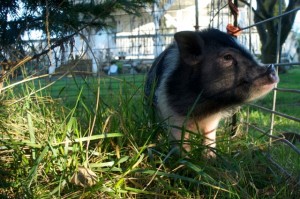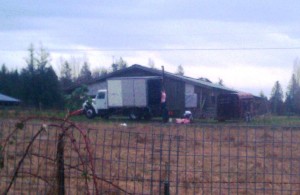As I’ve mentioned before, Eric and I try to get up to Pigs Peace Sanctuary once a week to volunteer. It’s a wonderful experience–not only getting away from town to do some good manual labor, but because we’re getting to build relationships with the pigs, dogs and humans at the sanctuary. Yesterday, we took a baby cedar tree that we had to remove from our yard and planted it at Pigs Peace, and then we were moving wood chips (my favorite job there). It had been a couple of weeks since we’d been there because of the snowy weather. While we were snowed in, a new pig came to the sanctuary. His name is Maynard and he is a potbellied piglet:

We got to meet him yesterday for the first time. When he first arrived at Pigs Peace, he had mange and was staying in the house with Judy since it was so cold outside. Now, he’s feeling much better and is trucking around the sanctuary exploring his new home and learning the ropes from the other pigs in the yard–Ziggy and Judee. Ziggy is a large one year old ‘farm’ pig who was born with only three legs. She is the official sanctuary greeter and spends her days hanging out in the yard, greeting visitors, eating lots of good treats like grass, carrots, and apples (from the orchard), and (yesterday) harvesting the leftovers from the vegetable garden. Judee is also a large ‘farm’ pig who was part of the main herd out in the field/woods area, but one day Judee hurt herself. The other pigs around her came to get Judy (the human) to let her know that Judee (the pig) was injured. Judee’s leg had been badly injured and she could barely walk, but Judy got her back to the yard and has been nursing her and keeping a close eye on her progress. None of the vets knew what was wrong with Judee’s leg, and they all suspected that it was only a matter of time before Judy would have to make the decision to euthanize her. A pig with a broken leg is normally viewed as a hopeless case. But Judy listened to Judee’s signals and watched her closely and Judee continued to let Judy know that she wanted to live–with lots of pig kisses and she made efforts each day to get up and wander around the yard with Ziggy as best she could. The two pigs have become fast friends and wherever one of them goes, the other is not far away.
Since we hadn’t been to the sanctuary in a couple of weeks, you can imagine our surprise when we arrived and Judee (the pig) was walking on her bad leg–still limping, but the improvement in her gait was like night and day when compared to two weeks ago. It turns out that Judee had three very serious types of infection deep inside her hip. In the last two weeks, the infections have worked themselves out of her body through several abscesses on her bad leg. Once the abscesses started draining, her leg started to improve rapidly. This is remarkably good news and a huge relief that she is on the mend.
While we were hauling wood chips, we suddenly heard a gun shot across the fence. Eric and I quickly went to the fence and noticed that there was a large truck and a small animal trailer at the neighboring farm. Two men were struggling with a pig they had just shot who was still writhing around violently on the ground outside the trailer. Using a knife, one of the men stabbed the pig and, slowly, the pig stopped writhing and became still. Then they dragged two other pigs out of the trailer and shot them both as well. You can imagine the horror of this scene just across the fence from the Pig Sanctuary. Judee and Ziggy were startled by the first shot and Judee wandered toward the fence to see what was happening. The men let the pigs bleed out and washed their bodies. Then they hoisted each pig up, one at a time, to hang at the back of the truck so they could skin and disembowel them. Apologies for the low-quality picture (I only had my phone camera with me):

I had never before witnessed in person an animal being slaughtered. My MA thesis was on ‘humane slaughter’ and I specifically focused on the Mobile Slaughter Unit (see above), but I relied on videos and texts for my research. The Mobile Slaughter Unit is touted as being the ‘most humane’ way to slaughter animals for food and operates as an ‘alternative’ to the industrial slaughter industry. These MSUs are trucks that have had the back converted into a USDA-approved slaughter facility. They travel to (mostly small-scale) farms to slaughter animals onsite. The MSU does offer small-scale farmers a way to have their animals slaughtered locally without the long transport distances which are stressful and oftentimes lethal to animals in the food industry. Despite the fact that this is most likely an improvement on industrial-scale slaughter, I can honestly say that the process of slaughter by the MSU looked far from humane. It was violent, incredibly bloody, and I can say with complete certainty that at least that first pig thrashed around for several minutes before he/she died.
My instinct was to look away, to turn back to the three pigs I knew were safe and happy–Ziggy, Judee, and Maynard–but I knew that there was something important–something absolutely necessary–about my witnessing the deaths of these three pigs. There was something essential about there being witnesses to document the violence that humans intentionally inflict on other humans and animals. Out of witnessing comes change. Maybe not today. Or tomorrow. But facing the violence of slaughter, and seeing it for the violence that it is has to be one step in a broader change of consciousness about the exploitation of animals. Eric and I left the sanctuary yesterday with a renewed sense that killing animals for taste is morally indefensible in a country where there are many food options beyond meat/dairy. The part that was so striking to us was not so much whether or not that pig suffered when he/she was slaughtered (I’m pretty certain that he/she did), but how those three pigs who had literally wound up on the wrong side of the fence could have such different experiences than the three pigs on the Judy’s side of the fence. Ziggy, Judee, and Maynard were rooting in the garden for carrots, potatoes, and beets while the three pigs on the other side of the fence were being slaughtered for someone’s dinner table.
I was in an academic workshop recently and we were talking about the ‘humaneness’ (or not) of animal slaughter. One of the attendees asked, “Well, how many of you have actually witnessed an animal being slaughtered?” A few people raised their hands, but the majority of the attendees had not witnessed an animal being slaughtered in person. The implication in this question was that you couldn’t make ethical assertions about the ‘humaneness’ of slaughter until you had witnessed it in person. Having not witnessed an animal being slaughtered at the time, I (and others in the workshop) became deeply troubled by this claim that, without witnessing, you couldn’t possibly make informed claims about whether or not we should kill animals for food. I certainly felt at the time that I did not need to see slaughter to know that there were ethical problems with it, but I also felt slightly paralyzed. That I somehow wasn’t part of the club. Somehow, I wasn’t as informed as those who had stared slaughter in the face and realized that it “wasn’t as bad as all that”. After having watched those three pigs be killed, I know two things:
1. Witnessing has its place. There is historical value in bearing witness to the violence of slaughter and recounting that violence to others as a method of reconceptualizing our relationship to other animals and exposing our implicatedness in the way those animals live and die.
2. You do not need to see slaughter to make informed moral arguments about it. The insistence on the part of the workshop participant that watching slaughter was necessary to enter into a conversation about it was successful in shutting down important conversations about human/animal relationships and the importance of challenging/reimagining the status quo.
What do you think?
 Follow
Follow

thank you for sharing your experience, this article is powerful and very thought provocing.
Do we need to see a child/soldier/parent killed to know that war is wrong? Do we need to see an execution to know that capital punishment is wrong? I think witnessing can be important, but are you any surer today that slaughtering animals for food is wrong than you were before you saw those pigs killed? Probably not. We already know in our in hearts that using people, animals, the earth for our own selfish purposes is just plain wrong. Love to you, Katie. I know how hard it was for you to have seen this.